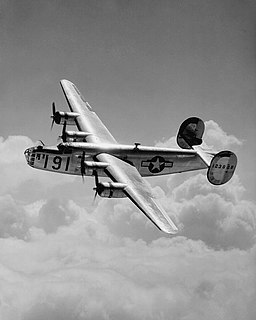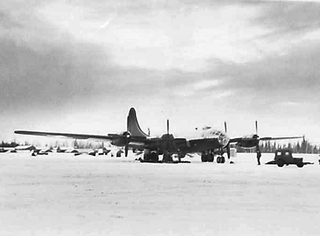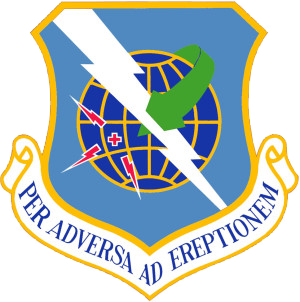| 582d Helicopter Group | |
|---|---|
37th Helicopter Squadron Bell UH-1N at F. E. Warren AFB | |
| Active | 1943-1958; 2015-present |
| Country | |
| Branch | |
| Role | Helicopter support for missile wings |
| Part of | Twentieth Air Force |
| Garrison/HQ | F. E. Warren Air Force Base, Wyoming |
| Nickname(s) | Snafu Snatchers |
| Engagements | Southwest Pacific Theater |
| Decorations | Distinguished Unit Citation Philippine Republic Presidential Unit Citation |
| Commanders | |
| Current commander | Col. David Smith [1] |
| Insignia | |
| 582d Helicopter Group emblem |  |
| 2d Emergency Rescue Squadron patch (World War II) |  |
The 582d Helicopter Group was activated in January 2015 at F. E. Warren Air Force Base, Wyoming to provide a unified headquarters for the helicopter squadrons located on the intercontinental ballistic missile bases of Air Force Global Strike Command.
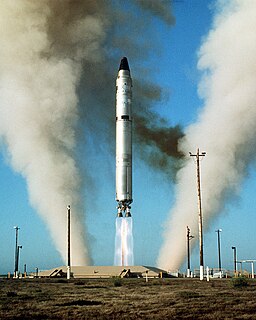
An intercontinental ballistic missile (ICBM) is a guided ballistic missile with a minimum range of 5,500 kilometres (3,400 mi) primarily designed for nuclear weapons delivery. Similarly, conventional, chemical, and biological weapons can also be delivered with varying effectiveness, but have never been deployed on ICBMs. Most modern designs support multiple independently targetable reentry vehicles (MIRVs), allowing a single missile to carry several warheads, each of which can strike a different target.

Air Force Global Strike Command (AFGSC) is a Major Command (MAJCOM) of the United States Air Force, headquartered at Barksdale Air Force Base, Louisiana. AFGSC provides combat-ready forces to conduct strategic nuclear deterrence and global strike operations in support of combatant commanders. It is subordinated to the USSTRATCOM.
Contents
- History
- World War II
- Post-war service in the Pacific
- Strategic missile support
- Lineage
- Assignments
- Components
- Stations
- Aircraft
- Awards and campaigns
- See also
- References
- Notes
- Citations
- Bibliography
- Further reading
- External links
The group was first activated in 1943 as the 2d Emergency Rescue Squadron at Hamilton Field, and after training, moved to the South Pacific Theater, where it served until the end of World War II, earning two Distinguished Unit Citations and a Philippine Republic Presidential Unit Citation for combat search and rescue and special operations missions. Following the end of the war, the squadron served as part of the occupation forces at Kadena Air Base, Okinawa from 1947 until 1950.

World War II, also known as the Second World War, was a global war that lasted from 1939 to 1945. The vast majority of the world's countries—including all the great powers—eventually formed two opposing military alliances: the Allies and the Axis. A state of total war emerged, directly involving more than 100 million people from over 30 countries. The major participants threw their entire economic, industrial, and scientific capabilities behind the war effort, blurring the distinction between civilian and military resources. World War II was the deadliest conflict in human history, marked by 50 to 85 million fatalities, most of whom were civilians in the Soviet Union and China. It included massacres, the genocide of the Holocaust, strategic bombing, premeditated death from starvation and disease, and the only use of nuclear weapons in war.
The Philippine Presidential Unit Citation Badge is a unit decoration of the Republic of the Philippines. It has been awarded to certain units of the United States military and the Philippine Commonwealth military for actions both during and subsequent to the Second World War.
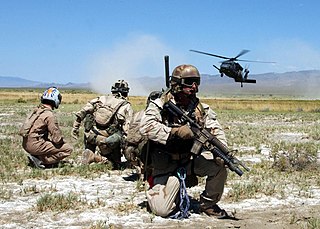
Combat search and rescue (CSAR) are search and rescue operations that are carried out during war that are within or near combat zones.
In May 1950 the squadron, now designated the 2d Rescue Squadron moved to Clark Air Base in the Philippines. In 1952, the unit was expanded to group level as the 2d Air Rescue Group and its lettered flights became air rescue squadrons. The group provided rescue support for units of Thirteenth Air Force and the southwest Pacific until 1955, when it moved to Wheeler Air Force Base, where it became the headquarters for all rescue units in the Pacific. The group was inactivated at Wheeler in June 1958.

A squadron in air force, army aviation, or naval aviation is a unit comprising a number of military aircraft and their aircrews, usually of the same type, typically with 12 to 24 aircraft, sometimes divided into three or four flights, depending on aircraft type and air force. Land based squadrons equipped with heavier type aircraft such as long-range bombers, or cargo aircraft, or air refueling tankers have around 12 aircraft as a typical authorization, while most land-based fighter equipped units have an authorized number of 18 to 24 aircraft.

Clark Air Base is a Philippine Air Force base on Luzon Island in the Philippines, located 3 miles (4.8 km) west of Angeles, about 40 miles (64 km) northwest of Metro Manila. Clark Air Base was previously a United States military facility, operated by the U.S. Air Force under the aegis of Pacific Air Forces (PACAF) and their predecessor organizations from 1903 to 1991. The base covered 14.3 square miles (37 km2) with a military reservation extending north that covered another 230 square miles (600 km2).
A group is a military aviation unit, a component of military organization and a military formation. The terms group and wing differ significantly from one country to another, as well as between different branches of a national defence force.
In 2015, the group was redesignated to its current name and activated at F. E. Warren, where it replaced a provisional unit that had been organized in 2014 to test the unification of helicopter units supporting missile wings under a single unit.




